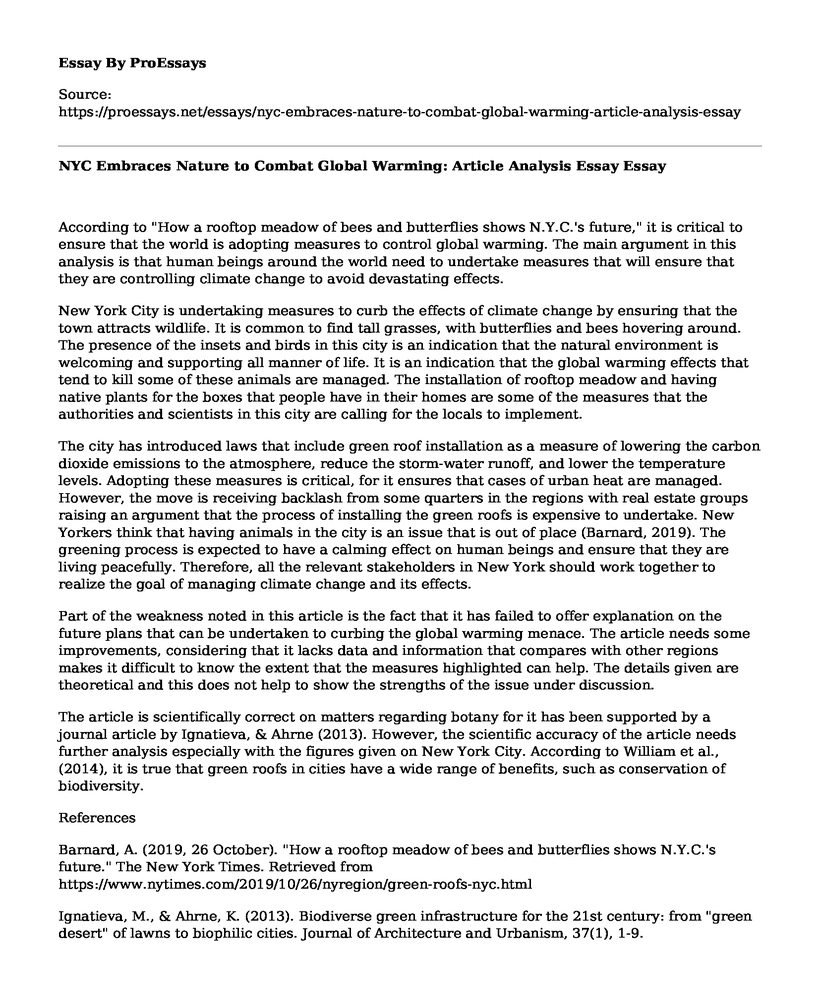According to "How a rooftop meadow of bees and butterflies shows N.Y.C.'s future," it is critical to ensure that the world is adopting measures to control global warming. The main argument in this analysis is that human beings around the world need to undertake measures that will ensure that they are controlling climate change to avoid devastating effects.
New York City is undertaking measures to curb the effects of climate change by ensuring that the town attracts wildlife. It is common to find tall grasses, with butterflies and bees hovering around. The presence of the insets and birds in this city is an indication that the natural environment is welcoming and supporting all manner of life. It is an indication that the global warming effects that tend to kill some of these animals are managed. The installation of rooftop meadow and having native plants for the boxes that people have in their homes are some of the measures that the authorities and scientists in this city are calling for the locals to implement.
The city has introduced laws that include green roof installation as a measure of lowering the carbon dioxide emissions to the atmosphere, reduce the storm-water runoff, and lower the temperature levels. Adopting these measures is critical, for it ensures that cases of urban heat are managed. However, the move is receiving backlash from some quarters in the regions with real estate groups raising an argument that the process of installing the green roofs is expensive to undertake. New Yorkers think that having animals in the city is an issue that is out of place (Barnard, 2019). The greening process is expected to have a calming effect on human beings and ensure that they are living peacefully. Therefore, all the relevant stakeholders in New York should work together to realize the goal of managing climate change and its effects.
Part of the weakness noted in this article is the fact that it has failed to offer explanation on the future plans that can be undertaken to curbing the global warming menace. The article needs some improvements, considering that it lacks data and information that compares with other regions makes it difficult to know the extent that the measures highlighted can help. The details given are theoretical and this does not help to show the strengths of the issue under discussion.
The article is scientifically correct on matters regarding botany for it has been supported by a journal article by Ignatieva, & Ahrne (2013). However, the scientific accuracy of the article needs further analysis especially with the figures given on New York City. According to William et al., (2014), it is true that green roofs in cities have a wide range of benefits, such as conservation of biodiversity.
References
Barnard, A. (2019, 26 October). "How a rooftop meadow of bees and butterflies shows N.Y.C.'s future." The New York Times. Retrieved from https://www.nytimes.com/2019/10/26/nyregion/green-roofs-nyc.html
Ignatieva, M., & Ahrne, K. (2013). Biodiverse green infrastructure for the 21st century: from "green desert" of lawns to biophilic cities. Journal of Architecture and Urbanism, 37(1), 1-9.
Williams, N. S., Lundholm, J., & Scott MacIvor, J. (2014). Do green roofs help urban biodiversity conservation?. Journal of applied ecology, 51(6), 1643-1649. doi.org/10.1111/1365-2664.12333
Cite this page
NYC Embraces Nature to Combat Global Warming: Article Analysis Essay. (2023, Mar 07). Retrieved from https://proessays.net/essays/nyc-embraces-nature-to-combat-global-warming-article-analysis-essay
If you are the original author of this essay and no longer wish to have it published on the ProEssays website, please click below to request its removal:
- Should Recycling be Mandatory?
- Technology Essay Example: Solar Panels
- Essay Sample on Climate Change Control
- Environmental Influences on Health and Healthcare and the Social Construction of Health and Disease - Essay Sample
- Essay Example on Global Warming: Unprecedented Climate Change in the 21st Century
- Protecting the Environment: The Role of Economic Incentives - Essay Sample
- Essay Example on Ozone Layer: Protection fFom Nitrogen Oxide (NOx) Sources







